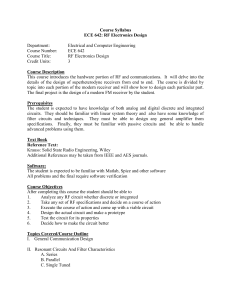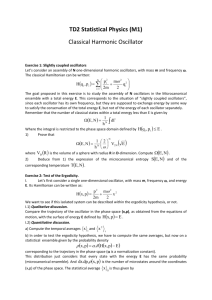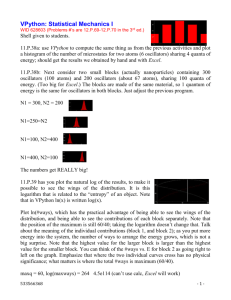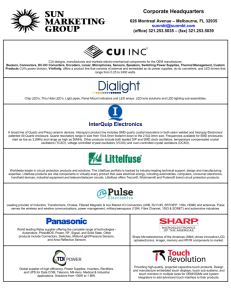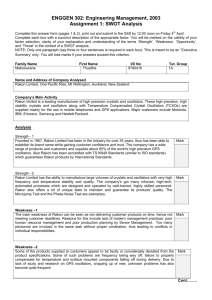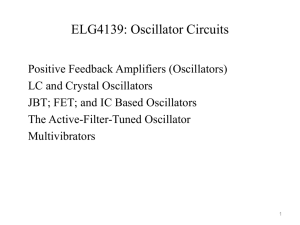CHAPTER 3: OSCILLATORS AND WAVEFORM
advertisement
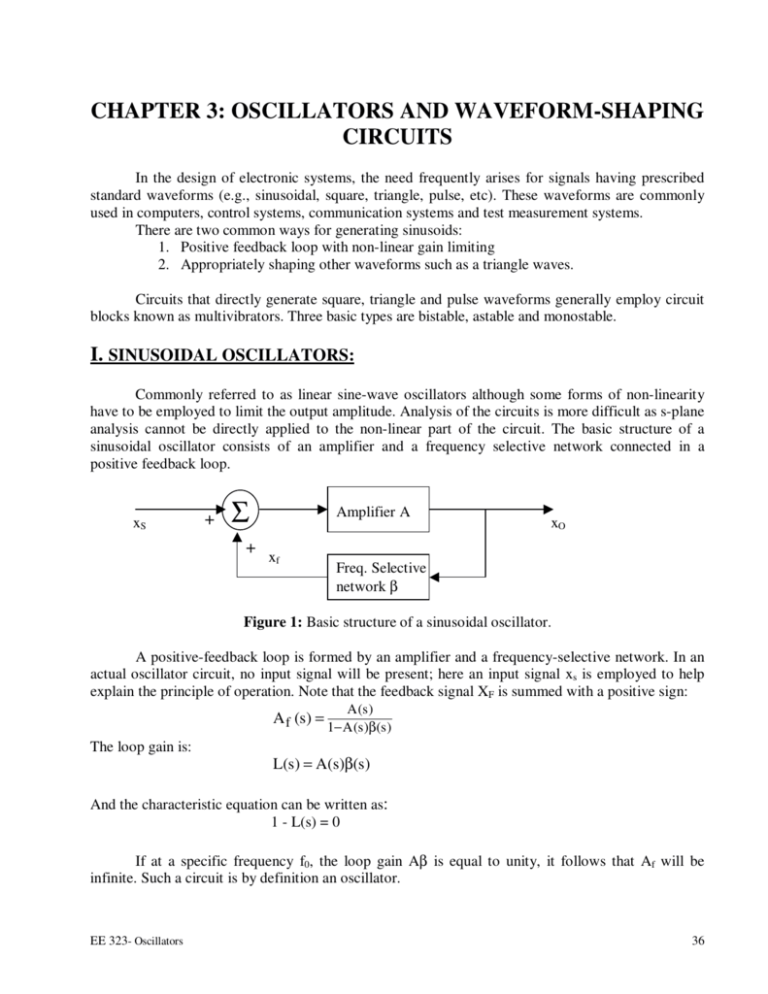
CHAPTER 3: OSCILLATORS AND WAVEFORM-SHAPING CIRCUITS In the design of electronic systems, the need frequently arises for signals having prescribed standard waveforms (e.g., sinusoidal, square, triangle, pulse, etc). These waveforms are commonly used in computers, control systems, communication systems and test measurement systems. There are two common ways for generating sinusoids: 1. Positive feedback loop with non-linear gain limiting 2. Appropriately shaping other waveforms such as a triangle waves. Circuits that directly generate square, triangle and pulse waveforms generally employ circuit blocks known as multivibrators. Three basic types are bistable, astable and monostable. I. SINUSOIDAL OSCILLATORS: Commonly referred to as linear sine-wave oscillators although some forms of non-linearity have to be employed to limit the output amplitude. Analysis of the circuits is more difficult as s-plane analysis cannot be directly applied to the non-linear part of the circuit. The basic structure of a sinusoidal oscillator consists of an amplifier and a frequency selective network connected in a positive feedback loop. xS + Σ + Amplifier A xf xO Freq. Selective network β Figure 1: Basic structure of a sinusoidal oscillator. A positive-feedback loop is formed by an amplifier and a frequency-selective network. In an actual oscillator circuit, no input signal will be present; here an input signal xs is employed to help explain the principle of operation. Note that the feedback signal XF is summed with a positive sign: A f (s) = The loop gain is: A (s ) 1− A (s )β(s ) L(s) = A(s)β(s) And the characteristic equation can be written as: 1 - L(s) = 0 If at a specific frequency f0, the loop gain Aβ is equal to unity, it follows that Af will be infinite. Such a circuit is by definition an oscillator. EE 323- Oscillators 36 Thus for the sinusoidal oscillator at ω0: L ( j ω 0 ) = A ( j ω 0 ) ⋅ β( j ω 0 ) = 1 This condition is called Barkhausen Criteria for oscillation, in which: “UNITY GAIN, ZERO PHASE SHIFT” It should be noted that the frequency of oscillation ω0 is determined by the phase characteristics of the feedback loop. The loop oscillates at the frequency for which the phase is ZERO. The steeper the phase shift as a function of frequency φ(ω), the more stable the frequency of oscillation. NON-LINEAR AMPLITUDE CONTROL: Generally, it is difficult to design circuits with Aβ=1 as circuit parameters vary with temperature, time, and component values. If If Aβ < 1 Aβ > 1 oscillator ceases, oscillation grows until circuit saturates. It is required to have a mechanism to force Aβ =1. This is accomplished by employing a nonlinear circuit for gain control: - Design circuit with Aβ >1 as voltage of oscillation increases, gain control mechanism kicks in and reduces gain to 1. - Design circuit with right half plane poles. The gain control pulls the poles back to the imaginary axis. Two approaches: EE 323- Oscillators 37 1. The first approach uses a limiter circuit, oscillations are allowed to grow until the level reaches the limiter set value. Once the limiter comes into operation, the amplitude remains constant. The limiter should be designed to minimize non-linear distortion. 2. The second method uses a resistive element in the feedback loop whose resistance can be controlled by the sinusoidal output amplitude. Diodes or JFETs (operating in triode region) are commonly used. A popular limiter circuit for amplitude control can be seen below: EE 323- Oscillators 38 II. OPAMP - RC OSCILLATORS: 1. WIEN-BRIDGE OSCILLATOR The loop gain can be found by multiplying the transfer function of the feedback path, Va(s)/V0(s), by the amplifier gain. L(s ) = [1 + ZP R2 ] R1 Z P + ZS 1+ L( jω) = by: R1 R2 3 + j(ωRC − 1 ) ωRC The loop gain will be a real number (i.e., the phase will be zero) at one frequency ω0 given ω0 RC = ω0 = 1 ω0 RC 1 RC To obtain sustained oscillation at this frequency, the magnitude of the loop gain should be unity which can be achieved by setting: R2 =2 R1 To ensure that oscillation starts, one chooses R2/R1 slightly greater than 2. EE 323- Oscillators 39 The amplitude of the oscillation can be controlled using a non-linear limiter as seen below. 2. PHASE SHIFT OSCILLATOR Figure 12.7 shows the basic structure of the phase shift oscillator. It consists of a negative gain amplifier (-K) with a three-section (3rd order) RC ladder network in the feedback. The circuit will oscillate at the frequency for which the phase shift of the RC network is 180O. Only at this frequency will the phase shift around the loop be 0O (360O). Three RC sections are required to produce a 180O phase shift at a finite frequency. The value of K is chosen to be slightly higher than the inverse of the magnitude of the RC network transfer function at the frequency of oscillation. EE 323- Oscillators 40 3. ACTIVE FILTER TUNED OSCILLATOR In this type of filter, Figure 12-10, a filter is used to select a particular frequency in the spectrum of a square wave (usually the fundamental frequency). Output of the filter is a sinewave and is taken as the output of the oscillator. The output is fed back to a limiter which is used to convert a sinewave to a squarewave. The squarewave signal then becomes the input of the filter. The actual circuit is shown in Figure 10.11, the limiter is a pair of diodes to have a squarewave at v2. This filter is an active filter (we will study this filter later) to select the fundamental frequency and provides the output at v1. The op-amp RC oscillator circuits are useful for operation in the 10Hz-1MHz range due to limitations in passive component size (low frequency) and op-amp slew rate (high frequency). For higher frequencies, circuits that employ transistors together with LC tuned circuits or crystals are commonly used. EE 323- Oscillators 41 III. LC AND CRYSTAL OSCILLATORS: Oscillators utilizing transistors and LC tuned circuits or crystals are useful for operation in the range from 100KHz to 500MHz. They exhibit higher Q than RC types (more stable). However, LC oscillators are difficult to tune over wide range of frequency and crystal oscillator operates at a single frequency. The extremely stable response of the crystal oscillators has made them very popular, particularly for digital timing signals. LC TUNED OSCILLATOR Two common used configurations are the Colpitts and the Hartley oscillators. The basic circuit structures without biasing can be seen below. EE 323- Oscillators 42 Both circuits utilize a parallel LC circuit connected between the collector and the base with a fraction of the tuned circuit voltage fed to the emitter of the transistor. The resistor R models the losses of the inductor, the load resistance of the oscillator and the output resistance of the transistor. If the frequency of operation is sufficiently low, we can neglect the transistor parasitic capacitances. The frequency of oscillation is determined by the resonant frequency of the parallel tuned circuit (also known as a tank circuit). For the Colpitts oscillator: ω0 = For the Hartley oscillator ω0 = 1 CC L( 1 2 ) C1 + C 2 1 C( L1 + L 2 ) The ratio L1/L2 or C1/C2 determines the feedback factor and thus must be adjusted in conjunction with the transistor gain to ensure that oscillations will start. To determine the oscillation condition for the Colpitts oscillator, we replace the transistor with its equivalent circuit. To simplify the analysis, we neglect the transistor capacitances except capacitance CBE is a part of C2. EE 323- Oscillators 43 A node equation at the transistor collector (C) yields: sC2 Vπ + g m Vπ + ( 1 + sC1 )(1 + s 2 LC2 )Vπ = 0 R Since Vπ ≠0 (oscillations have started), it can be eliminated (i.e., the other terms are zero). C 1 s3LC1C 2 + s 2 (L 2 ) + s(C1 + C 2 ) + (g m + ) = 0 R R (g m + 1 ω2 LC 2 − ) + j[ω(C1 + C 2 ) − ω3LC1C 2 ] = 0 R R For oscillations to start, both the real and imaginary parts must be zero. Setting the imaginary part to zero gives ω0 = L( which is the resonant frequency of the tank circuit. Setting the real part to zero yields 1 C 1 C2 C1 + C 2 ) C2 = g mR C1 For sustained oscillation, the magnitude of the gain from the base to collector (gmR) must be equal to the inverse of the voltage ratio provided by the capacitive divider: v be C1 = v ce C 2 For oscillation to start, the loop gain must be greater than unity which is equivalent to C gmR > 2 C1 As oscillation grows in amplitude, the transistors non-linear characteristics reduce the loop gain to unity, thus sustaining oscillations. An example of a complete Colpitts oscillator is shown below EE 323- Oscillators 44 The radio frequency choke (RFC) in this oscillator provides a high reactance at ω0 but a low DC resistance. Unlike the op-amp oscillators that incorporate special amplitude control circuitry, LC tuned oscillators utilize the non-linear ic-vbe characteristics of the BJT (or id versus vgs for FET) for amplitude control. As the oscillations grow, the effective gain of the transistor is reduced below its small signal value. The LC tuned oscillators are known as self-limiting oscillators. Reliance on the non-linear characteristics of the BJT (or the FET) implies that the collector (drain) current waveform will be nonlinearity distorted. Nevertheless, sinusoidal of high purity because of the filtering action of the LC tuned circuit. CRYSTAL OSCILLATORS A piezoelectric crystal, such as quartz, exhibits electro-mechanical resonant characteristics that are very stable (with time and temperature) and high selectivity (having very high Q factor). The circuit symbol of a crystal is shown below. The resonant properties are characterized by a large inductance L (as high as hundreds of Henrys), a very small series capacitance Cs (as small as 0.0005pF), a series resistance r representing a Q factor (Q=ω0L/r that can be as high as few hundred thousand) and a parallel capacitance Cp (a few picoFarad). EE 323- Oscillators 45 Capacitance Cp represents the electrostatic capacitance between the two parallel plates of the crystal (Cp>>Cs). Since the Q factor is so high, we can neglect the resistance r and express the crystal impedance as: Z(s) = 1 sC p + which can be manipulated to the form 1 sL + 1 / sCs s2 + 1 1 LC s Z(s) = sC p s 2 + C p + C s L(C p C s ) we see that the crystal has two resonant frequencies: ωs = 1 LCs and ωp = L 1 CsC p Cs + C p they are series resonance and parallel resonance. For s=jω close. 1 ω2 − ωs2 Z( jω) = − j ( ) ωC p ω2 − ω2p It can be seen that ωp>ωs, however, since Cp>>Cs, the two resonant frequencies are very EE 323- Oscillators 46 From Figure 12.15, we observe that the crystal reactance is inductive over a narrow frequency band between ωp and ωs. We may use the crystal to replace the inductor in a Colpitts oscillator. The resulting circuit will oscillate at the resonant frequency of the crystal inductance L with the series equivalent of Cs and (C + C1C 2 ) . p C1 + C 2 Since Cs is much smaller than the other capacitances, it will dominate and 1 = ωs LCs A popular configuration of the Colpitts oscillator called Pierce oscillator is shown below. ω0 = Resistor Rf determines the DC operating point in the high gain region of the CMOS inverter. Resistor R1 together with capacitor C1 provides a LPF that discourages the circuit from oscillating at higher harmonic of the crystal frequency. Common to purchase crystal modules with TTL, CMOS or ECL outputs with 14 pin dip or surface mount. Crystals are available in standard frequencies and can be custom ordered for relatively low cost. The oscillators can be tuned a small amount with the use of variable capacitor (varactor) to create Voltage Control Crystal Oscillator (VCXO). Crystals are also be used in high Q filters such as crystal filters or SAW filters. EE 323- Oscillators 47 VOLTAGE CONTROLLED OSCILLATORS (VCO) There are IC oscillators with output rate variable over some range of frequency according to an input control voltage. Some have frequency range from 1000:1. An example is 74LS624, the IC generates digital logic levels up to 20MHz using external RC to set. Faster VCO available in the 200MHz-1GHz range. Many VCO use external crystals for accuracy. Commonly varactor is used to control frequency of oscillation. Vcontrol IV. MULTIVIBRATORS: 1. Bistable Multivibrator: This multivibrator has two stable states. The circuit can remain in either stable state indefinitely and moves to the other stable state only when triggered. Bistability can be obtained by connecting an amplifier in a positive feedback loop having loop gain greater than unity. This circuit has 2 stable states, one with the op-amp in positive saturation and the other with the op-amp in negative saturation. EE 323- Oscillators 48 Triggering the bistable circuit: If the circuit is in the positive saturation (L+) state, it can be switched to the negative saturation (L-) state by applying an input vI of value greater than vTH=βL+ vI initiates or triggers regeneration. Thus we can remove vI with no effect on the regeneration process, vI can simply be a pulse which is commonly referred to as a trigger signal. The circuit is known as the Schmitt trigger. A simple change in the input converts the circuit into a non-inverting bistable circuit. EE 323- Oscillators 49 circuit. The output levels of the bistable circuit adjusted by cascading the op-amp with a limiter 2. Astable Multivibrator: A square waveform can be generated by making a bistable multivibrator switch state periodically. This can be done by connecting the bistable mutivibrator with an RC circuit in the feedback loop. This circuit has no stable state and is called an astable multivibrator. EE 323- Oscillators 50 The voltage at the op-amp inverting terminal during charging cycle is: t v − = L + − ( L + − β L − )e τ − Substituting v-=βL+ at t=T1 gives where τ = RC L 1−β − L+ T1 = τ ln( ) 1− β Similarly for the discharge cycle, it can be shown L 1− β + L− ) T2 = τ ln( 1− β If L+=L- and T=T1+T2 then T = 2τ ln 1+ β 1− β • The square wave generator can be made to have variable frequency by adjusting C and/or R. • The waveform across C can be made almost triangular by using a small value for the parameter β. EE 323- Oscillators 51 Generation of triangle waveforms: The exponential waveform generated in the astable circuit can be changed to triangular by replacing the low pass RC circuit with an integrator. The integrator causes linear charging and discharging of the capacitor. Because the integrator is inverting, it is necessary to use the noninverting bistable circuit. VTH − VTL L + = T1 CR V − VTL T1 = CR TH L+ VTH − VTL − L − = T1 CR V − VTL T2 = CR TH − L− IF L+=L- then symmetrical waveforms are obtained 3. Monostable Multivibrator: In some applications, the need arises for a pulse of known height and width generated in response to a trigger signal. Because the width of the pulse is predictable, its trailing edge can be used for timing purposes. Such a pulse can be generated by a monostable multivibrator. The monostable multivibrator has one stable state in which it can remain indefinitely. It also has a quasi-stable state in which it remains for a predetermined interval equal to the desired width of the output pulse. Once the interval expires, the monostable returns to the stable state and remains there awaiting another triggering signal. The circuit is commonly called a one shot. The monostable circuit shown below is an augmented form of the astable circuit. EE 323- Oscillators 52 The duration T of the output pulse is determined by the exponential waveform at vB. By substituting vB(T)=βL-, v B ( t ) = L − − (L − − VD1 )e βL − = L − − (L − − VD1 )e − − t C1R 3 T C1R 3 V − L− ) T = C1R 3 ln( D1 βL − − L − For VD1 << |L-|, this equation can be approximated by 1 T ≈ C1R 3 ln( ) 1− β Note: the monostable should not be re-triggered again until C1 has been recharged to VD1 (recovery period) EE 323- Oscillators 53 INTEGRATED CIRCUIT TIMERS Commercially available integrated circuit packages contain a bulk of the circuitry needed to implement monostable and astable multivibrators having precise characteristics. The most popular of such IC’s is the 555 timer. EE 323- Oscillators 54 Monostable circuit using 555 timer t v C = VCC (1 − e RC ) − EE 323- Oscillators 2 v C = VTH = VCC 3 t=T T = CR ln( 3) ≈ 1.1CR 55 Astable circuit using 555 timer: EE 323- Oscillators 56 The rise in vC is given by: v C = VCC − ( VCC − VTL ) e 2 v C = VTH = VCC 3 − t C(R A + R B ) t = TH 1 VTL = VCC 3 TH = C( R A + R B ) ln( 2) ≈ 0.69C( R A + R B ) The fall in vC is given by: v C = VTH e − t CR B 1 v C = VTL = VCC 3 t =T L 2 VTH = VCC 3 TL = CR B ln( 2) ≈ 0.69CR B The total period is: T = TH + TL = 0.69C( R A + 2 R B ) EE 323- Oscillators 57 EE 323- Oscillators 58 EE 323- Oscillators 59 EE 323- Oscillators 60 EE 323- Oscillators 61 EE 323- Oscillators 62 EE 323- Oscillators 63 EE 323- Oscillators 64 EE 323- Oscillators 65 EE 323- Oscillators 66 EE 323- Oscillators 67
